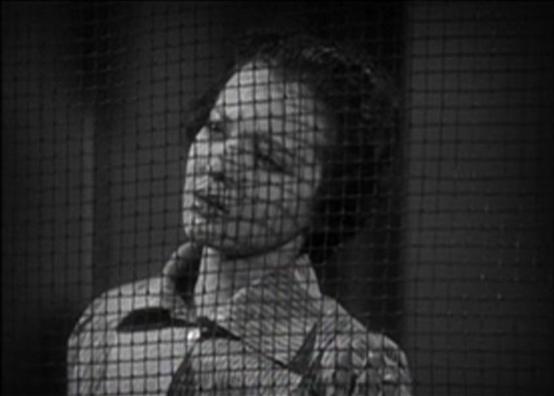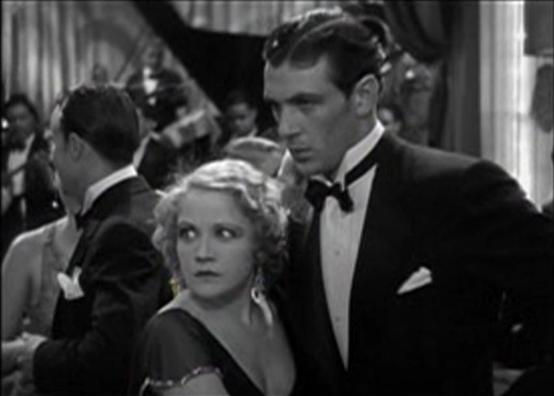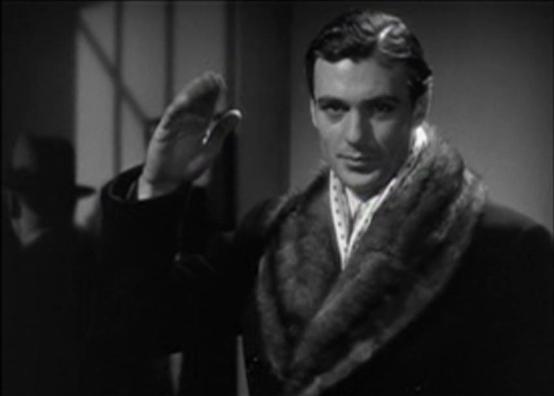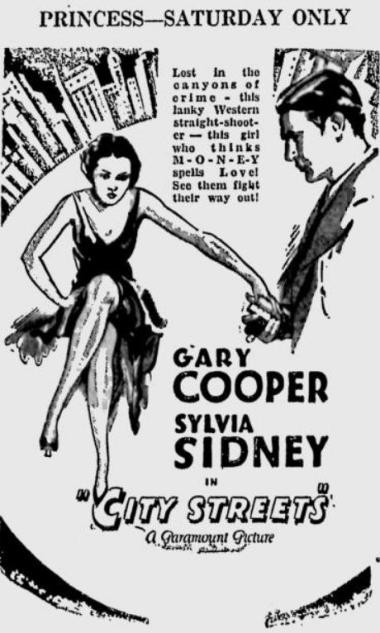While Warner Bros. released the best remembered gangster films throughout 1931, including a pair of all-time classics joined at the hip ever since, Little Caesar and The Public Enemy, Paramount reluctantly allowed director Rouben Mamoulian the freedom to create the most stylistically daring crime film of that year, City Streets starring Gary Cooper and Sylvia Sidney.
Mamoulian, whose only previous film credit had been the critically acclaimed Applause (1929), perhaps the best of that early wave of musicals though still a box office flop, claimed City Streets grossed over $3 million at the box office after being made on a budget of $330,000 (Stevens, Jr.). The director, who next brought his unique touch to the horror genre in Dr. Jekyll and Mr. Hyde (1931), is credited with being the first to utilize the voiceover in City Streets, overcoming studio objections that audiences would find the technique confusing in doing so. But contemporary crowds picked right up on it and the jailhouse scene containing the innovation plays as one of the most dramatic in City Streets as leading lady Sidney agonizes over the potential consequences of Cooper’s joining the dangerous beer racket that has already led to her own incarceration. Far from being a one-trick pony, City Streets is filled with Mamoulian’s trademark shadowy scenes of expressionism, resulting in this one often carrying the proto-noir label today.
While I’m more apt to group this with the other early ‘30s gangster films myself, the film noir label also attaches itself thanks to the man who birthed the original story for City Streets, legendary hardboiled novelist Dashiell Hammett. The first version of Hammett’s most famous story, The Maltese Falcon, did not arrive in theaters from Warner Bros. until a couple of months after Paramount released City Streets, but that novel along with Red Harvest had already made Hammett a major literary name when Paramount paid $5,000 for his brief treatment, originally titled After School. In a July 18, 1930 memo to Paramount studio chief B.P. Schulberg, David O. Selznick wrote that Hammett, “might very well prove to be the creator of something new and startlingly original for us” (Hammett).
After School was adapted into City Streets by Max Marcin, who we previously bumped into during coverage of the later Crime Doctor series, and turned into a screenplay by Oliver H.P. Garrett, who had just finished working with Marcin on Scandal Sheet, an excellent movie focused on a hardnosed newspaper publisher as portrayed by George Bancroft. While Marcin and Garrett supplied a very different ending to Hammett’s original treatment, Hammett does provide all of the main characters and several incidents from the first half of the film that remain almost entirely intact as he originally wrote them. His characters, the Girl and the Kid (Sylvia Sidney and Gary Cooper in the film) do begin his story as 16-year-olds, their youthfulness giving title to After School, but five years are allowed to pass while the Girl does time covering for Pop in a crime nearly matching the action of the Mamoulian film.
 Some sources credit City Streets as an amalgamation of Hammett’s story and the earlier Paramount film Ladies of the Mob (1928), a silent directed by William A. Wellman and starring Clara Bow, but the similarities seem very basic. In Ladies of the Mob, Bow plays the daughter of an executed criminal with a background otherwise similar to Sidney’s Nan in City Streets. The Bow character falls in love with a criminal (Richard Arlen) but given what had happened to her father Bow does all she can to steer Arlen straight. Clara Bow was originally slated to star alongside Gary Cooper in City Streets, but she lost the job amongst a round of very harsh publicity surrounding the Daisy De Voe trial. Both James Robert Parish and John Springer have written that Paramount originally cast Bow in City Streets because it offered the then struggling star a character similar to one she had already found success with in Ladies of the Mob. Perhaps that has led to some confusion, but as Ladies of the Mob is currently considered a lost film, the details of what exactly occurs throughout that movie are lost to time.
Some sources credit City Streets as an amalgamation of Hammett’s story and the earlier Paramount film Ladies of the Mob (1928), a silent directed by William A. Wellman and starring Clara Bow, but the similarities seem very basic. In Ladies of the Mob, Bow plays the daughter of an executed criminal with a background otherwise similar to Sidney’s Nan in City Streets. The Bow character falls in love with a criminal (Richard Arlen) but given what had happened to her father Bow does all she can to steer Arlen straight. Clara Bow was originally slated to star alongside Gary Cooper in City Streets, but she lost the job amongst a round of very harsh publicity surrounding the Daisy De Voe trial. Both James Robert Parish and John Springer have written that Paramount originally cast Bow in City Streets because it offered the then struggling star a character similar to one she had already found success with in Ladies of the Mob. Perhaps that has led to some confusion, but as Ladies of the Mob is currently considered a lost film, the details of what exactly occurs throughout that movie are lost to time.
In City Streets the Girl, now called Nan (Sidney), is raised by her step-father, Pop Cooley (Guy Kibbee), who opens the movie as bodyguard to racketeer Blackie (Stanley Fields). The boss of the outfit, called the Big Fellow (Paul Lukas), promotes Pop to Blackie’s place after Blackie catches the Big Fella canoodling with his girl, Agnes (Wynne Gibson), and decides that the easiest way out of this potentially tight spot is to just have Pop gun down Blackie.
Just before Pop hits Blackie he calls stepdaughter Nan and tells her to meet him on the corner in fifteen minutes, even if she has to break her arm to get there. Nan catches the signal, creates a makeshift sling for her arm, and deposits the murder weapon inside before walking off to follow Pop’s order and drop it in the river. The bit with the sling came to the story after Hammett and is a nice visual addition.
A suspicious beat cop catches Nan but she keeps her mouth shut under questioning back at the station. Pop arrives and promises her, “Nobody in the beer racket ever washed out on a pal yet.” Until now. Nan, preoccupied with keeping her midnight date with the Kid (Cooper) at the shooting gallery where he works, is an easy sell for Pop and winds up being sent to prison.
After Nan’s arrest Pop approaches the Kid at the shooting gallery. Nan had talked up the Kid as a sharpshooter, and he proves it in the presence of Pop and his bodyguard, McCoy (William Boyd). Up until now the Kid has steadfastly resisted Nan’s prodding him to join Pop in the beer racket, but after Pop tells him that the cops framed Nan and that they could help her by working together, the Kid caves in and joins the racket.
Up until this point the film very closely follows Hammett’s original treatment. The author even gets credit for some of the best lines in the movie, such as when Kibbee twists Sidney’s arm while attempting to get her to spill where she’s been, but rewards her for keeping quiet. “Good kid. Don’t never tell nobody nothing,” Pop says, peeling a bill off of his roll for Nan, after uttering the line exactly as Hammett had originally written down. Hammett skimps on the prison scenes though, simply jumping ahead five years, and a very different girl emerges from his reform school than the bitter yet more mature woman of the film. Sidney’s Nan is now tortured to such an extent by the idea of the Kid’s turning to the beer racket that director Mamoulian has to invent that voiceover device in order to fully punctuate her heartbreak.
Once out of prison, Nan does her best to convince the Kid to get out of the racket. She’s cold towards Pop and frigid towards the Big Fellow, who she’s only meeting for the first time after her release. The Big Fellow has cooled on Agnes himself and becomes obsessed with taking Nan away from the Kid, who by this time has developed into his right-hand man. After the Big Fellow monopolizes Nan on the dance floor at a party he has thrown in her honor, both Agnes and the Kid are pushed to their limit and each takes steps that earn the wrath of the Big Fellow.
From there we wind towards an ending that rises in excitement on a pace equal to the Kid’s speedometer but comes to just as quick a full stop that, as story goes, winds up feeling anticlimactic. Perhaps I was looking for the body count to rise, but we get a simple parting of the ways instead. The ending of the film actually plays better than the confusing mishmash Hammett originally had wrapped with, as all loose ends are tied up, even if they’re knotted without any additional thrills.
Several individual scenes highlight City Streets, especially during the more exciting first half of the movie. The carnival setting adds its usual color though quieter scenes such as those shared by Cooper and Sidney alone at the beach and facing each other on either side of the visitor’s gate in prison are the true highlights of City Streets. While some actors are underused (William “Stage” Boyd) and others are miscast (Paul Lukas), the two stars both deliver strong performances, especially Sidney, and other supporting roles are expertly handled by actors such as Guy Kibbee and Wynne Gibson.
 While Sylvia Sidney had previously played support in 1929’s Thru Different Eyes for Fox, the experience had soured her on Hollywood enough to send her packing back to Broadway. She would shuttle back and forth between the coasts many times throughout her career, preferring theatrical work in the East, but a willing recipient of Hollywood riches when they came calling. City Streets was her first film under contract to Paramount, beginning the busiest decade of her movie career, the 1930s.
While Sylvia Sidney had previously played support in 1929’s Thru Different Eyes for Fox, the experience had soured her on Hollywood enough to send her packing back to Broadway. She would shuttle back and forth between the coasts many times throughout her career, preferring theatrical work in the East, but a willing recipient of Hollywood riches when they came calling. City Streets was her first film under contract to Paramount, beginning the busiest decade of her movie career, the 1930s.
Sidney was rediscovered in the East by the wife of Paramount studio head B.P. Schulberg. A big mistake as Sidney and Schulberg went on to conduct one of Hollywood’s most public affairs from the time of her signing through the end of 1934. Nevertheless Sidney originally had to be sold on inking her Hollywood contract and Schulberg managed to do so by dangling the key role of Roberta Alden in Paramount’s adaption of Theodore Dreiser’s An American Tragedy. By the time Sidney was under contract, Clara Bow ran into her difficulties and was dropped from City Streets just prior to production. Another studio star, Nancy Carroll, refused the role. Director Rouben Mamoulian was familiar with Sidney from working together in the Theatre Guild during the 1920s and recommended the brand new contract player as Bow’s replacement.
In 1994 interview with Jeff Laffel for Films in Review Sidney recalled, “Mamoulian told the money people, ‘If you give me this girl, I will give you a star.’” She went on to credit the director for her fine performance in the film: “Look, he carried me through that picture. He was a great teacher and a great director, and I will always be indebted to him for his genius and for his confidence in me.”
Perhaps my favorite Sylvia Sidney scene in City Streets finds her with Cooper on the staircase at Pop Cooley’s after the Kid has just shooed away two hitmen that the Big Fellow had sent after him. When the Kid tells her that he’s going back to have a session with the Big Fellow, Nan begs him to stay. Sidney wraps her arms around Cooper’s neck and the much taller actor descends the stairs with her clinging to him, Sidney’s feet dragging along the stairs as Cooper goes. At the bottom of the stairs Cooper peels Sidney off of him and exits leaving Sidney to pound against the door begging, “Kid, come back! You fool.” Her voice breaks down with the rest of her body and through teary eyes she winds up repeating the final word of her plea, “Fool,” an uncomfortable number of times. Defeated she throws a halfhearted kick at the door, now behind her, takes a weak punch at the air and begins to pace the floor. Out of her heartbreak she settles on a solution. She reaches of the phone, instinctively pulling her hand back the first time, before picking up the receiver and composing herself enough to offer herself as the ultimate sacrifice to the Big Fellow in exchange for the Kid’s safety.
Sidney was excellent at these extreme snaps of emotion and her bosses knew it. Her characters were continuously pushed to their breaking point, eventually wallowing in tears so pathetically that you just beg for someone to come and hold her and tell her it’s all going to be okay. But a Sylvia Sidney character usually doesn’t need any help in pulling herself together and turning hardboiled to solve her own problems. She does it in Ladies of the Big House (1931), Pick Up (1933), Good Dame (1934), Mary Burns, Fugitive (1935), Fury (1936) and You Only Live Once (1937), just to name a few! In a 1966 piece for Films in Review, Sidney’s press agent, John Springer, wrote that he considered her the finest emotional actress of them all. Yes, he worked for her, but other clients included stars from Bette Davis and Joan Crawford to Marlene Dietrich and Marilyn Monroe, so I don’t expect he was being flattering just for the sake of his article.
Gary Cooper, who is noticeably thin in his part as the Kid, was just getting over a period of illness as work began on City Streets. If you walked in on City Streets when it was half-over, you would think Cooper was terribly miscast as a mob hitman, but his character begins the film as the earthy man-of-few-words that we associate him with playing. His development into a racketeer is all the more interesting because of his background with a highlight coming when his Kid directs a driver to ride through a waiting mob of hijackers, whooping a “Yeehaw!” after the driver crashes past them. When the Kid visits Nan in prison he comes decked out in his fine new clothes causing Nan to ask if the circus was in town. “Don’t you like my get up?” he asks. After crushing Nan by telling her he’s working with Pop now, he adds, “You had it right, Babe. It’s great. I love it.” Cooper is appropriately naive up until the time he realizes that the Big Fellow is looking to wrest his girl away from him. At that point all bets are off as his Kid has spent the entire movie establishing himself as a quick and sure shot, leaving the other gangsters wary of crossing him.
Guy Kibbee is often credited with playing against type as the lecherous Pop Cooley, but the type being referred to hadn’t been established for Kibbee yet. As I noted when writing about Hugh Herbert, who Warner Bros. turned buffoon about the same time as Kibbee, their earliest film efforts, such as this one for Kibbee, better show us the true range of some of these already veteran actors who seemed more limited later on. Each came from the stage where they had been doing more versatile work over a period of decades. Kibbee, who later played some comic louses, is wonderful here as a completely self-interested crook, who leers at his step-daughter and casually runs through the details of a hit on his superior with the boss’s own moll, who covers for him along with a burning cigar.
City Streets was released in April 1931, coming well after January’s Little Caesar but a few days ahead of The Public Enemy at a time when other crime films, such as MGM’s Gentleman’s Fate and yet another Warner Bros. title The Finger Points, also had been recently released. Thanks to Mamoulian, City Streets is the most sophisticated of the bunch and while, according to the director, it was a box office smash in its day, seems to have fallen well behind the better known pair in terms of modern popularity.
Despite the legendary status of leading man Gary Cooper and writer Dashiell Hammett, in addition to Mamoulian’s own popularity, City Streets seems to have somewhat fallen through the cracks because, like so many other early Paramount titles, it has (to the best of my knowledge) never had a home video release in North America. Turner Classic Movies will play the title every so often, though it is not scheduled near the time of this writing.
The Prohibition-era gangland romance is well worth finding, even if the ending is a bit of a letdown.
Sources
- Hammett, Dashiell. The Hunter and Other Stories
. New York: The Mysterious Press, 2013.
- Laffel, Jeff. “Sylvia Sidney.” Films in Review Sep/Oct 1994: 2-19.
- Parish, James Robert. The Paramount Pretties
. New Rochelle: Arlington House, 1972.
- Springer, John. “Sylvia Sidney.” Films in Review Jan 1966: 6-16.
- Stevens, Jr. George. Conversations with the Great Moviemakers of Hollywood’s Golden Age at the American Film Institute
. New York: Random House, 2009.
















So I finally saw this at Film Forum … and I was disappointed. Don’t like it nearly as much as you do.
I guess I’m not too surprised; you know I don’t like much of the early 30’s stuff – the phony tough-guy talk is often annoying, though sometimes you get these lines that are unintentionally funny cuz of how silly they are, like:
“Who’s running this mob now?”
“I am.”
“Says who?”
“Says I.”
😀
Sylvia Sidney is always good – I loved her the moment I saw her in DEAD END, an absolutely marvelous performance. Gary Cooper IMO is one of the most overrated actors in Hollywood history; IMO he was generally just an average actor who maybe had good looks.
Also, these early 30’s movies didn’t yet know how to use music – surprising, since silent films were all about music! That scene where they are in the club is, to my recollection, the only music in the movie. When the movie fades from one scene and begins the next, it is noticeable how quiet it is without music (this was the case even on the great early 30’s movies, like THE PUBLIC ENEMY).
Anyway, I enjoyed reading your review, as always. Nice research. This was indeed part of a Chandler/Hammett/Cain/Woolrich series at Film Forum http://filmforum.org/series/chandler-hammett-woolrich-cain-series-page even though it probably would be considered a gangster film.
I didn’t even know that any studios were doing those movies then other than WB 😉
Well, I’m disappointed you didn’t care for it, but yeah, I guess I’m not shocked.
Cooper isn’t a favorite of mine either, but he does play well with Sidney, who is an all-time favorite of mine. Their scenes at the beach and at the prison are great! Oh, and Sylvia hanging onto him on the stairs, but that one is pretty much all SS.
Paul Lukas wasn’t a great choice for The Big Fella, but otherwise I was okay with most of the casting. Always interesting to see Guy Kibbee as such a sleaze, since he’d soon be so likable at WB.
It’s changed quite a bit (for the better) from Hammett’s original few pages, but some of his original ideas stuck, especially during the first half of the film, so that made it an interesting read for me.
Without giving away any of the details on this page, the ending still feels a bit sudden to me. Other than that and Lukas, I don’t have much of anything negative to say.
Gary Cooper was a wonderful actor and the best most beautiful looking man to ever grace the big screen. Obviously the previous chap never saw his later movies. From ‘Souls at Sea’ to High Noon’ he was superlative!!